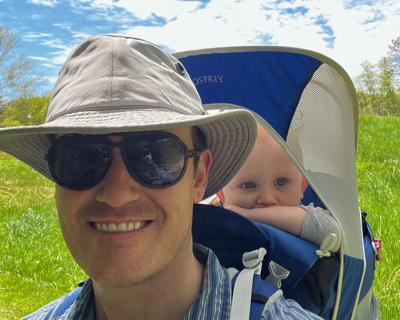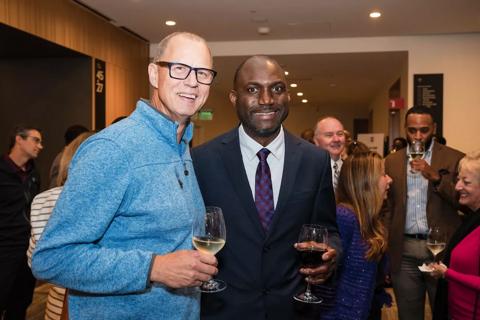Advertisement

Art Steffee, MD (GS’62/ORS’67), known as “The Father of Modern Spine Surgery,” is the 2023 recipient of the Cleveland Clinic Alumni Association’s Distinguished Alumnus Award. The award recognizes “exceptional, enduring achievements and leadership that have brought pride and recognition to the Cleveland Clinic community.”
Advertisement
Cleveland Clinic is a non-profit academic medical center. Advertising on our site helps support our mission. We do not endorse non-Cleveland Clinic products or services. Policy
Dr. Steffee was Director of Orthopedic Services at Lutheran Medical Center’s Cleveland Spine and Arthritis Center, as well as Former Chair of Orthopedic Surgery at St. Vincent’s Hospital. While on staff at St. Vincent Charity Hospital in Cleveland in 1982, he invented the pedicle screw system to stabilize the spine, which revolutionized spine surgery.
For a Spring 2023 Alumni Connection article, Dr. Steffee recalled that his invention arose from a problem he encountered during surgery in 1982. “At that time, all we had was the Luque System, with which we needed to have the laminae so we could pass a wire under it and around a rod to stabilize that particular vertebra.” However, all the laminae had been removed. He improvised by using a bone screw that he put down the pedicle with a washer and wired to the spine. “It worked so well that when the next case came along, I said, ‘Well, let’s do it again.’ That’s how it all started.”
Dr. Steffee continued modifying his approach with the help of Louis Keppler, MD (ORS’83), Chief Resident at St. Vincent Charity Hospital in Cleveland. Together, they created the first spine plate surgery with pedicle screws. In 1983, as a fellow at the Texas Scottish Rite Hospital for Children in Dallas, Dr. Keppler invited Dr. Steffee to give a talk to other physicians about his innovation. This presentation launched his career in the same year that he founded AcroMed to produce the spinal implants, artificial vertebrae and total lumbar artificial discs that he designed, developed and patented.
In nominating Dr. Steffee for the Distinguished Alumnus Award, Edward Benzel, MD (Staff’99), a neurosurgeon at Cleveland Clinic’s Center for Spine Health, noted that Dr. Steffee was one of the first surgeons to use non-fusion technology, implanted the first lumbar and cervical total artificial disc replacements in the United States, and authored over 30 scientific articles on the spine. He also established Steffee Orthopedics, which later became Horizon Orthopedics.
Dr. Steffee retired from practicing medicine in 1996. Each year, in recognition of his achievements, Cleveland Clinic’s Neurosurgery Institute offers a Spinal Review Course that includes a guest lecture named for him.
Long before his residency there, Dr. Steffee had a close connection with Cleveland Clinic when he married his first wife, Edith Hodgkinson. “My first father-in-law, Cecil B. Hodgkinson, was with George Crile Sr. in Moulins, France, in WWI,” he says. “When the war was over, he was Dr. Crile’s lab tech, and Dr. Crile said that he should go to medical school. He replied, ‘I was born in Canada, and I also have no money.’ Dr. Crile sent him to the University of Indiana and paid for his education. Then he got my father-in-law a job at St. Vincent’s Charity Hospital, the oldest hospital in the city and where the bigger names practiced – George Crile, Frank Bunts, everybody. When my father-in-law got this internship, a fellow intern was Bunts’ son Alexander. They became lifelong friends, and I met him several times at their home. My father-in-law and Alexander Bunts, MD (S’28) went to Dr. Crile and Dr. Lower and that group who had just started Cleveland Clinic and said, ‘There is lots of cutting at St. Vincent’s but no formal education. It would be nice if you guys would start a fellowship.’ That’s how it got started at Cleveland Clinic.”
Advertisement
After medical school at McGill University in Montreal, Dr. Steffee says, he was among the first group of interns at Cleveland Clinic. “The next year, my brother, a physician who also trained at Cleveland Clinic, went in from the University of Pennsylvania and was in the same group of interns as Caldwell Esselstyn, MD (S’66, S’68). I know the history of Cleveland Clinic very well.”
Part of his training was at Charity Hospital. “All orthopedic residents had to spend half a year in each of their junior and senior years there because Cleveland Clinic was not accredited for all units of orthopaedics. They didn’t have an open emergency room. We learned to set broken bones and take care of accidents. That’s how I got to Charity Hospital, and my association with Cleveland Clinic for many years was through the residency training program. We had a friendly, competitive attitude toward each other, and we beat Cleveland Clinic with total hip replacement. But we were both teaching the same residents and working for the same cause.”

Dr. Art Steffee receiving his award, presented by Richard Lang, President of the Alumni Association Board
Even with his fame and accomplishments, Dr. Steffee expresses surprise at being selected for the Distinguished Alumnus Award because after his residency, he turned down an offer by Cleveland Clinic, choosing to work at Charity Hospital, instead. Even so, he says, he is proud to be an alumnus. “Louis Keppler is very high on the Cleveland Clinic, and so am I,” he says.
“For nearly 37 years we were friendly competitors, teaching young orthopaedists. We trained an awful lot of orthopaedic surgeons, and Dr. Keppler is still doing it. Close to 100 of them. So, even though I never joined Cleveland Clinic, I am proud to have trained their residents. That was the fun part!”
Advertisement
Advertisement

We celebrate the exceptional achievements of four future alumni

Meet Hardeep Phull, MD (CCLCM’11)

Meet William Tierney, MD, MS (CCLCM’16, OTO’18)

Meet Samuel Omotoye, MD (CARD/E'15)